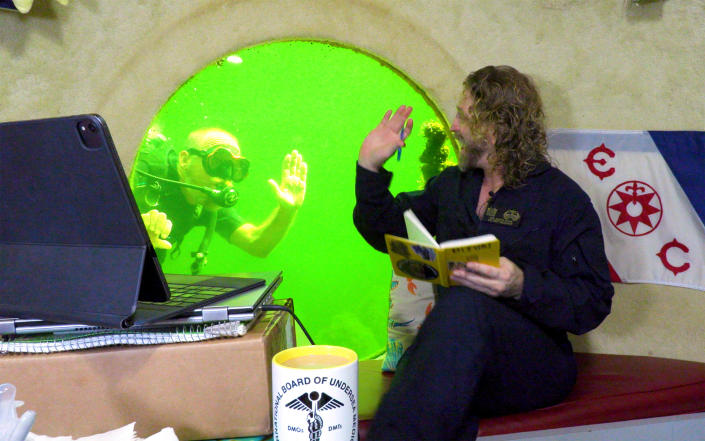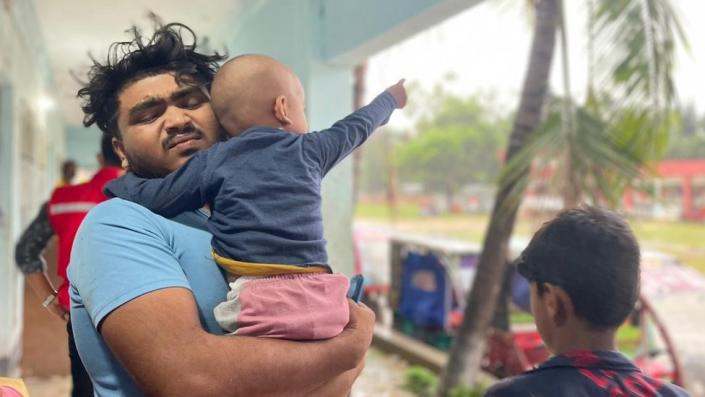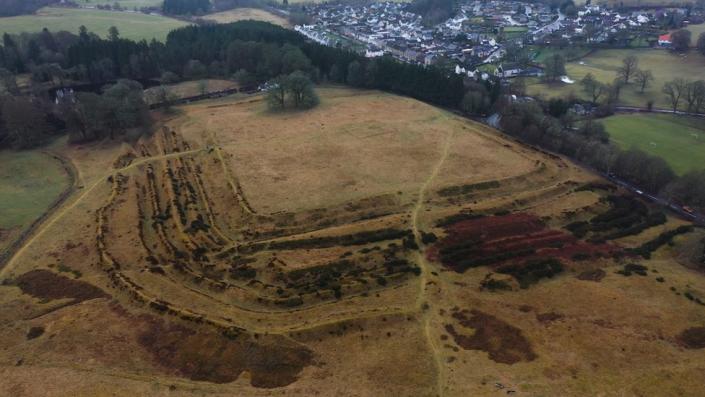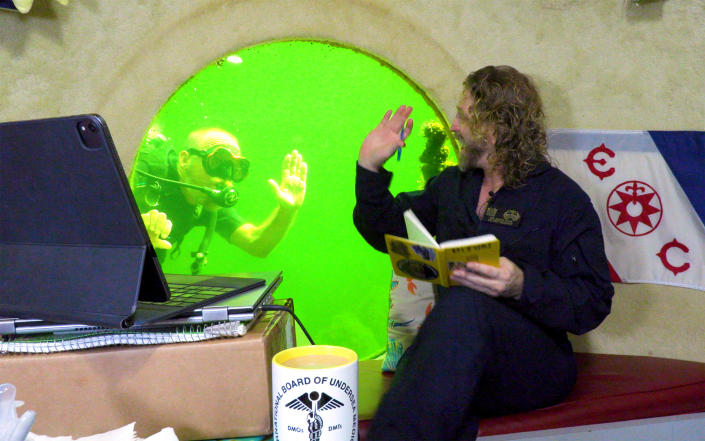Science Daily News | 15 May 2023

Views (189)

A scientist scraped a black dot on his forehead and filmed it under a microscope, revealing dozens of crawling face mites
Face mites are tiny creatures that live on just about every human's face. They live, reproduce, and die in skin pores. But they're pretty harmless.

A scientist scraped a black dot on his forehead and put it under a microscope.
He saw dozens of tiny face mites, aka Demodex mites, crawling around on the plate.
Demodex are harmless and like to live on human faces as well as on all other mammals.
They sound like something from a horror film, but these mysterious, microscopic creatures are very real.
They live their entire lives on your body and eventually die and decompose all within the pores of your face. Sound like a fun time?
Here's a closer look at what these mites look like.
"They're not just on us; they're on all mammals. So they evolved initially on early mammals and they've speciated as mammals have speciated," Trautwein told Insider.
The fascinating footage and images of these mites featured in the YouTube video came from James Weiss' own face.
After seeing a tiny black dot on his forehead, Weiss scraped the spot with a microscope slide and took a look.
They are mostly found on faces, especially Demodex folliculorum, but can also be found in other greasy parts of our bodies, Trautwein said, like ear canals, noses, and pubic areas.
Demodex mostly stay in your pores except at night when they emerge to find other Demodex to mate with.
"They crawl around on your face, having a great time visiting their friends in other hair follicles," Robinson said.
The thought of hundreds of mites crawling around your face at night might give you the creeps, but for the most part, these tiny animals cause no harm to humans and can actually help balance the skin microbiome.
"The good thing about the Demodex mite is that he's our friend," Robinson said. "In most cases, he's just chewing up dead skin and getting rid of it, and also getting rid of that excess oil we don't need."
"There is a harmony in the skin, good types of bacteria and microorganisms, and if you disturb that harmony then you can sometimes create other problems," Robinson said. "So I wouldn't advocate for getting rid of something unless it is causing other issues."
For Trautwein, these tiny creatures tell an important story about the history of humanity and our connection to all other animals.
"I think a major misconception people have is that humans are somehow not part of the natural order," Trautwein said. "We think we are distinct and we can separate ourselves from nature and other animals, but that isn't the case."
Our face mites are a testament to that.
"We're just out here like the rats and the dogs; we all have these mites," she said. "We're all just part of this ancient mammalian heritage."
Kerry challenges oil industry to prove its promised tech rescue for climate-wrecking emissions
Oil and gas producers talk up technological breakthroughs they say will soon allow the world to drill and burn fossil fuels without worsening global warming. U.S. climate envoy John Kerry says the time is here for the industry to prove it can make the technology happen — at scale, affordably and quickly — to stave off climate disaster. Kerry's comments came in an interview with The Associated Press on one of the most crucial topics in the fight to slow global warming: the argument from oil and gas producers that they will soon have technology in place to extract the climate-damaging gases that make fossil fuels the main culprit in climate change, allowing companies to keep pumping crude and natural gas worry-free.

And Kerry says he has “serious questions” whether it can.
Kerry said the ideal solution is a fast global switch to renewable energy, but oil and gas states and companies have a right to give their claim of technological rescue a try.
“If you're able to abate the emissions, capture it,” Kerry said this past week at his climate team's offices at the State Department. “But we don't have that at-scale yet. And we can’t sit here and just pretend we’re going to automatically have something we don’t have today. Because we might not. It might not work.”
“What they’re banking on is that they’re going to be able to do the emissions capture,” Kerry said of oil and gas companies. He ticked off the stages of operations that would involve.
“If you can do those things, you may be able to make it economically competitive,” he said, adding, “I have some serious questions about whether it will be price-competitive.”
Especially since 2015, when the United States and nearly 200 other governments committed to cut emissions to avoid the most disastrous scenarios of global warming, oil producers have spent hundreds of millions of dollars in public campaigns portraying themselves as climate-friendly. Industry ads and social media campaigns often suggest the carbon-purging technology is already on the job, extracting the climate-damaging gases from oil and gas facilities' around the world.
“CO2 capture and transportation technologies have been operating safely across the globe and in the US for many years,” the website of oil giant BP says.
“Technologies capture CO2 emissions at source or directly from the air,” Saudi state oil giant Aramco says, describing the carbon then being stored safely underground or turned into “useful products.”
The International Energy Agency, some national governments globally, and many climate scientists and advocates are adamant that while carbon-capturing technology will play a role, oil and gas production itself must be phased out.
“Actual experience has been that commercial-scale carbon capture projects have fallen far, far short of the claims,” said David Schlissel of the Institute for Energy Economics and Financial Analysis research group.
“I just think it's foolish to think that we can keep pumping the stuff, CO2, methane, into the atmosphere, and that at some point we'll be able to capture it,” Schlissel said.
A spokeswoman with the American Petroleum Institute trade group declined comment. An industry study group in 2019 called for heavy government funding to capture a quarter of current greenhouse gases within 15 years.
- API supports federal policies to achieve the “at-scale phase” of CCUS commercial deployment,
The fight — fast production cuts versus technological rescue — promises to come to a head this year.
Annual U.N.-sponsored climate talks meant to help keep countries on track to meet their pledges to cut emissions are being held this year in the United Arab Emirates.
The talks will be hosted by Sultan al-Jaber, the chief executive officer of the Emirates' state oil company. Like the U.S. and several other countries, the Gulf nation is expanding drilling even as it champions the climate cause.
Going into November's climate talks, al-Jaber is calling for a phase-out of ‘’fossil fuel emissions," leaving it ambiguous whether he means a ramping up of technology or is open to some production cuts.
At the 2021 U.N. climate talks in Scotland, countries for the first time agreed to phase down the global use of coal. Talks the next year in Egypt saw a major push for a commitment to phase out oil and gas, but it failed.
While nonbinding, any agreement out of this year's climate talks that the world should start phasing out oil and gas production would be a first. It would put governments and the industry on the spot to comply.
Kerry rejected the idea of putting a deadline on phasing out oil and gas production. How fast that can happen depends partly on how fast the world moves to electric vehicles and renewable-fueled power grids, he said.
Instead, he said, this year’s climate talks will “quite possibly” produce an international agreement to phase out the use of “unabated” oil and natural gas, meaning oil and gas where the carbon emissions are not captured. This could disappoint those calling for fast cuts in oil and gas production.
Kerry said the deadline to watch is 2030. By then, the U.N.’s top climate panel says, the world will need to have nearly halved climate-damaging emissions to stave off the more devastating scenarios of global warming.
“We can’t let the wish or the hope govern common sense here,” Kerry said. “If we know that we can get the job done by deploying more renewables and current technology, we ought to be doing that.”
He likes to be, under the sea: Florida man sets record for living underwater
A university professor broke a record for the longest time living underwater without depressurization this weekend at a Florida Keys lodge for scuba divers. Joseph Dituri’s 74th day residing in Jules’ Undersea Lodge, situated at the bottom of a 30-foot-deep lagoon in Key Largo, wasn’t much different than his previous days there since he submerged March 1. Dituri, who also goes by the moniker “Dr. Deep Sea,” ate a protein-heavy meal of eggs and salmon prepared using a microwave, exercised with resistance bands, did his daily pushups and took an hour-long nap.

KEY LARGO, Fla. (AP) — A university professor broke a record for the longest time living underwater without depressurization this weekend at a Florida Keys lodge for scuba divers.
Joseph Dituri’s 74th day residing in Jules’ Undersea Lodge, situated at the bottom of a 30-foot-deep lagoon in Key Largo, wasn’t much different than his previous days there since he submerged March 1.
The previous record of 73 days, two hours and 34 minutes was set by two Tennessee professors -- Bruce Cantrell and Jessica Fain -- at the same location in 2014.
But Dituri isn't just settling for the record and resurfacing: He plans to stay at the lodge until June 9, when he reaches 100 days and completes an underwater mission dubbed Project Neptune 100.
The mission combines medical and ocean research along with educational outreach and was organized by the Marine Resources Development Foundation, owner of the habitat.
“The record is a small bump and I really appreciate it,” said Dituri, a University of South Florida educator who holds a doctorate in biomedical engineering and is a retired U.S. Naval officer. “I’m honored to have it, but we still have more science to do.”
His research includes daily experiments in physiology to monitor how the human body responds to long-term exposure to extreme pressure.
“The idea here is to populate the world’s oceans, to take care of them by living in them and really treating them well,” Dituri said.
The outreach portion of Dituri’s mission includes conducting online classes and broadcast interviews from his digital studio beneath the sea. During the past 74 days, he has reached over 2,500 students through online classes in marine science and more with his regular biomedical engineering courses at the University of South Florida.
While he says he loves living under the ocean, there is one thing he really misses.
“The thing that I miss the most about being on the surface is literally the sun,” Dituri said. “The sun has been a major factor in my life – I usually go to the gym at five and then I come back out and watch the sunrise.”
Cyclone Mocha: Deadly storm hits Bangladesh and Myanmar coast
The most powerful cyclone to hit the Bay of Bengal in more than 10 years made landfall.

A powerful cyclone has hit the coastlines of Bangladesh and Myanmar after intensifying into the equivalent of a category-five storm.
Cyclone Mocha brought with it heavy rain and strong winds, leaving residents in low-lying coastal areas fearful they may lose their homes.
More than 1,300 bamboo shelters in Cox's Bazar, the world's largest refugee camp, have been destroyed.
At least five people have been reported dead in Myanmar.
Landslides and floods are also hitting the area.
As the storm approached, police patrolled the coastline in the town of Cox's Bazar carrying loudspeakers, urging people to stay indoors.
The streets emptied as the cyclone intensified - the skies darkened, the winds picked up pace and the rains pounded down.
Hundreds of people crammed into a school in the city which had been turned into a temporary cyclone shelter.
Mothers with babies, young children, the elderly and the frail packed into any available space in the classrooms, sleeping on desks and sitting under them.
Authorities here say more than 500,000 people were evacuated from their homes in this south-eastern stretch of Bangladesh.
As many arrived at the shelter in rickshaws and on foot, they brought their livestock - cattle, chickens, goats - as well as mats to sleep on.
They had come from fishing and coastal villages, as many as two hours away, making a difficult choice.
"I didn't want to leave my house," said Sumi Akter, who lives on a riverbank.
Sumi and others we met here say they have lived through other cyclones in recent years and are resigned to the regular pattern of leaving their homes to the mercy of nature.
Storm surges of up to four metres could swamp villages in low-lying areas, Sumi and others here are fearful their homes may be submerged.
"I wish the homes we lived in were built more strongly," she said.
Jannat, aged 17, who we had met the day before in the same shelter, said she too was terrified of what state her home, on the riverbank, would be in once she went back.
Last year, another cyclone, Sitrang, destroyed her house, forcing her to spend what little money she had on repairing it.
"How can I live if this keeps happening? I can't afford to rebuild it - we are very poor," she said.
Nature was also punishing the poor in the world's largest refugee camp nearby.
Bangladesh's government does not allow Rohingya refugees to leave the camps, nor to build permanent structures.
As the cyclone hit, they hunkered down in flimsy bamboo shelters with tarpaulin roofs. Some were moved to community shelters within the camps, which offered little more protection.
Authorities told the BBC that more than 1,300 shelters were damaged by the wind, as were 16 mosques and learning centres. Trees had fallen in the camps, while two landslides also caused some damage.
The tarpaulin that covered Mohammed Ayub's shelter was torn off by the winds. Now he and his family of eight are living in the open, in wet and miserable weather.
Having spent the days before terrified of what Cyclone Mocha could bring, Mohammed was relieved the camps didn't take a direct hit from the storm.
Mizanur Rahman, from the Refugee Relief and Repatriation Commissioner said that as far as he was aware, there were no casualties in the camps as a result of the cyclone.
Forecasters warned Cyclone Mocha could be the most powerful storm seen in Bangladesh in nearly two decades. It also hit neighbouring Myanmar with great force.
Heavy rain and driving winds battered the region as the storm system moved to the coast, with reports of increasing disruption near the city of Sittwe, in Myanmar, from about 13:00 (07:00 GMT).
Electricity and wi-fi connections were disrupted across much of the Sittwe area, where videos showed the tide rising dramatically and carrying debris down flooded streets.
A telecom tower was brought down by the high winds as the cyclone approached. Videos shared on social media also showed roofs being blown off houses and billboards flying off buildings in Yangon amid teeming rain.
Images from the city of Mrauk U showed palm trees bending in the wind, metal roofing sheets being swept into the street and a few people still hurrying to take cover in storm shelters.
Local media reported that a 14-year-old boy was killed by a falling tree in Myanmar's Rakhine State, while there were reports of damaged and collapsed buildings in various parts of Myanmar.
The Bangladeshi meteorological department office said the maximum sustained wind speed within 75km (45 miles) of the centre of the cyclone was about 195km/h (120mph), with gusts and squalls of 215km/h.
In preparation for the storm's arrival, nearby airports had been shut, fishermen were ordered to suspend their work and 1,500 shelters were set up as people from vulnerable areas were moved to safer spots.
Authorities in Cox's Bazar said no lives were lost as a result of the Cyclone, despite the ferocity of the storm.
As families began to leave their shelters once the storm had passed, there was relief.
Evacuations in this area have been credited for saving lives, as the extreme weather continues to disrupt them.
Tracing Scotland's unique place in the Roman world
New research is highlighting the extraordinary extent of what the Romans built in Scotland.

It is a commonly-held view that the Romans did not spend a long time in Scotland or have much interest in it - but new research is highlighting the extraordinary extent of what they built and their persistence in trying to subdue the Caledonian tribes.
Dr Andrew Tibbs, an honorary research fellow in archaeology at Durham University, has carried out a digital survey of almost 100 sites thought to be linked with the first invasion of Scotland in the decade after 70AD.
It happened at a time when the Romans may have thought they could conquer the whole of the country and before they built Hadrian's Wall and the later Antonine Wall in a bid to secure the empire's north-western border.
Dr Tibbs says: "For the Romans, campaigning in Scotland is almost a bit of a prestige piece.
"Several emperors are keen to do it because it's a part of the country that's never been conquered.
"It's never been fully occupied on a long-term basis. It's a military zone, it's a war zone. It's comparable with what's happening in Ukraine at the moment."
Dr Tibbs says his survey is the first big-data study of the positioning of all the early Roman sites and their relationship with the landscape.
It combines remote sensing techniques with existing archaeological and historical data and precise details of the terrain held in a digital geographical information system.
This wealth of data meant Dr Tibbs was able to reach a better understanding of why the Romans built where they did.
For example, Bochastle fort near Callander is placed between two rivers and orientated towards a glen heading north into the highlands.
Dr Tibbs says: "It's very much designed to restrict or control anybody moving up and down the glen.
"These people have never seen anything like the Romans, they're going to approach, see these big forts and the idea is that they submit to them, they're afraid of them.
"The Romans are in control."
So-called glen blockers are a characteristic feature of the line of forts stretching north east from the central belt through Perthshire into Aberdeenshire.
This network of forts and camps allowed the Romans to manage the corridor of land they were advancing through without having to control the entire landscape.
Their careful planning and building didn't always keep them safe.
Dr Tibbs says there is a record of a night attack in which all the soldiers in a fort were massacred.
But his findings do chime with what the Roman writer, Tacitus, said about Agricola's campaign.
He wrote: "It has been observed by experts that no general ever showed a better eye for ground than Agricola.
"No fort on a site of his choosing was ever taken by storm, ever capitulated, or was ever abandoned".
Perhaps the most striking example of the Roman remains in Scotland is Ardoch fort just a couple of miles off the A9 at Braco in Perthshire.
It's one of the best preserved Roman forts anywhere in the territories of the empire - an extraordinarily complex system of ditches and ramparts, which must have seemed impregnable to the local tribes in that area.
And yet its location in rural Perthshire and the relative lack of interest in the Romans in Scotland mean it is not well known.
Dr Tibbs worries about the number of sites in Scotland that have not been fully investigated.
"Scotland has a fairly unique place in the Roman world," he says.
"It's on the edge of the empire. They keep invading, they try to conquer and it just doesn't happen.
"But we've got 300-odd sites across Scotland that we think are Roman and there's very little research, almost no research going on into them.
"This archaeology isn't going to be around forever. Climate change, agricultural works all do tremendous amounts of damage to the sites that we know about and we can keep an eye on.
"But there are so many others that we need to investigate. It's just not getting done and I just think that one day we'll lose that and we'll never really find out the full extent, the true story of what the Romans were doing in Scotland".
For someone so committed to understanding and explaining his subject, that is a painful prospect.
Florida man breaks record for longest time living underwater
University of South Florida professor Joseph Dituri has spent more than 74 days at an underwater Florida Keys lodge. He's already broken the record for living underwater and plans to stay at Jules' Undersea Lodge until he hits 100 days.

Saturday was Joseph Dituri's 74th day living at Jules' Undersea Lodge. The previous world record, set by two other professors in 2014, was 73 days. Dituri plans to make it to 100 days underwater.
"The curiosity for discovery has led me here," he tweeted early on Sunday. "My goal from day 1 has been to inspire generations to come, interview scientists who study life undersea and learn how the human body functions in extreme environments."
Jules' Undersea Lodge is located at the bottom of a 30-foot lagoon in Key Largo, Florida. During his stay, Dituri has been studying how the human body reacts to living under extreme pressure for long periods of time. And he's not just learning about himself — he's also still teaching his biomedical engineering class online, according to the University of South Florida (USF.)
Dituri's underwater mission, dubbed Project Neptune 100, was organized by the Marine Resources Development Foundation. The project uses the uniqueness of the study's location to bring awareness to marine research and conservation efforts, according to the foundation. The project also studies the impact of compression on the body.
Dituri, who served in the Navy for nearly three decades and left to learn more about traumatic brain injuries, has hypothesized that his health will improve because of the increased pressure underwater.
A medical team is doing routine dives to Jules' Undersea Lodge to run tests on Dituri, according to USF. Dituri has completed a series of psychosocial, psychological and medical tests, including blood panels, ultrasounds and electrocardiograms, as well as stem cell tests. A psychologist and psychiatrist are also documenting the mental impacts of living in an isolated and confined environment for a lengthy period of time.
The professor plans to resurface on June 9. Until then, he's keeping busy. Dituri wakes up at 5 a.m. each day to exercise, according to Florida Keys News Bureau. His protein-heavy meals underwater feature eggs and salmon. He has access to a microwave.
Dituri hasn't been completely alone underwater. More than 30 adults and 15 middle and high school students have spent time at the undersea lodge in the last 74 days, according to Florida Keys News Bureau.
While Dituri has loved living under the ocean, there's one thing in particular he's missed.
"The thing that I miss the most about being on the surface is literally the sun," Dituri told Florida Keys News Bureau.
0 Likes
